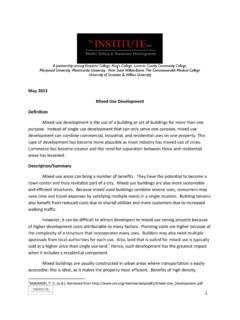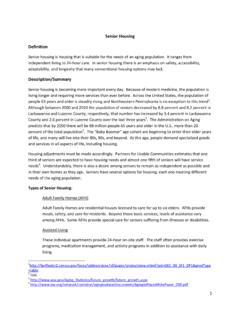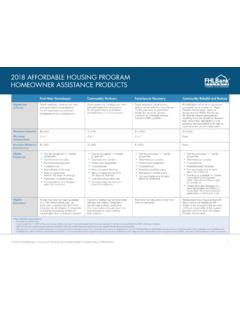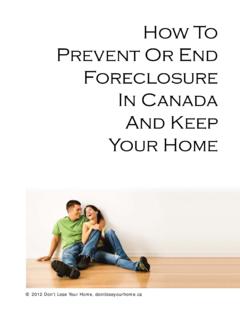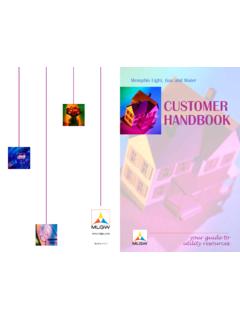Transcription of Senior Housing Definition Description/Summary
1 1 Senior Housing Definition Senior Housing is Housing that is suitable for the needs of an aging population. It ranges from independent living to 24-hour care. In Senior Housing there is an emphasis on safety, accessibility, adaptability, and longevity that many conventional Housing options may lack. Description/Summary Senior Housing is becoming more important every day. Because of modern medicine, the population is living longer and requiring more services than ever before. Across the United States, the population of people 65 years and older is steadily rising and Northeastern Pennsylvania is no exception to this trend1. Although between 2000 and 2010 the population of seniors decreased by percent and percent in Lackawanna and Luzerne County, respectively, that number has increased by percent in Lackawanna County and percent in Luzerne County over the last three years2.
2 The Administration on Aging predicts that by 2050 there will be 88 million people 65 years and older in the , more than 20 percent of the total population3. The Baby Boomer age cohort are beginning to enter their elder years of life, and many will live into their 80s, 90s, and beyond. At this age, people demand specialized goods and services in all aspects of life, including Housing . Housing adjustments must be made accordingly. Partners for Livable Communities estimates that one third of seniors are expected to have Housing needs and almost one fifth of seniors will have service needs4. Understandably, there is also a desire among seniors to remain as independent as possible and in their own homes as they age.
3 Seniors have several options for Housing , each one meeting different needs of the aging population. Types of Senior Housing : Adult Family Homes (AFH) Adult Family Homes are residential houses licensed to care for up to six elders. AFHs provide meals, safety, and care for residents. Beyond those basic services, levels of assistance vary among AFHs. Some AFHs provide special care for seniors suffering from illnesses or disabilities. Assisted Living These individual apartments provide 24-hour on-site staff. The staff often provides exercise programs, medication management, and activity programs in addition to assistance with daily living. 1 2 Ibid.
4 3 4 2 Residential Care Housing in private homes for fewer than ten people with daily life assistance, meals, laundry, housekeeping assistance, personal care, and planned activities from 24 hour staff. Independent Living Housing that may not provide assistance, but is rented or purchased by seniors at a subsidized rate. Some services or programs are typically offered to residents, but services are less comprehensive than assisted living or residential care Housing . Independent living is also called Elderly Housing , Senior Housing or Senior Apartments Non-profit Age & Income-Qualified Housing . Subsidized or age/income-qualified Housing Government Housing assistance is available to eligible low-income and very-low-income elderly persons 62 years of age and older through the Department of Housing and Urban Development's (HUD) three major programs: Public Housing , Housing Choice Voucher Program, and Section 202.
5 Public Housing and the Housing Choice Voucher Program are managed by local public Housing authorities. Section 202 Housing is sponsored on a complex-by-complex basis by nonprofit companies. Nursing Care and Rehabilitation Commonly referred to as Nursing Homes, or Skilled Nursing Facilities (SNF), these facilities are licensed to provide assistance services and rehabilitative care for occupational or speech therapy and sometimes specialized care for patients with Alzheimer s Disease or other specialized needs. Continuing Care Retirement Community (CCRC) These are retirement communities that offer varying levels of assistance throughout the lives of residents. Residents have lifetime contracts that ensure care as needs change.
6 Continuing Care Retirement Communities are also called Life Care Communities. Accessory Apartments An Accessory Apartment is an individual dwelling unit attached to an existing single-family home. They can be either a part of the interior of a home, added onto the existing structure, or even included in the original design for the home. It is most commonly family members sharing 3 the structure with either the adult child caregiver living in the apartment or the elder living in the apartment attached to his or her child s family For an older homeowner, an Accessory Apartment enables him or her to affordably remain in their own home, in their familiar community setting receiving supplemental income, assistance with maintenance, and the sense of security that comes from having others Local planning or zoning laws can sometimes present an obstacle to accessory apartments, which are often not permitted in single family residential neighborhoods.
7 California, Massachusetts and cities like Portland, Oregon, Cary, North Carolina, and Chicago, Illinois, have changed zoning laws in order to allow owners of single-family homes to rent out part of their house as an apartment. This allows seniors to find affordable, smaller, and more manageable living space, perhaps adjacent to a family member or other caregiver. It has the added benefit of making use of existing Housing without shrinking a municipality s tax base. Aging in Place An overwhelming majority (89 percent) of baby boomers want to grow old in their own While this is an understandable desire, it can also be very problematic for municipalities across the country. One third of older adult households are predicted to have Housing needs and one fifth of older adults are expected to have service However, many houses were not built with the needs of elderly occupants in mind.
8 For example, multiple-story houses have stairs that pose a challenge for many seniors. Narrow hallways and doorways can also be problematic those with limited mobility. Bathrooms and kitchens can also be difficult to navigate for older people. Aging in place programs offer seniors the ability to stay in their homes as long as they want. The National Association of Home Builders designates Certified Aging-in-Place Specialist (CAPS).9 CAPS are typically home remodelers, contractors, or designers who are trained to make changes to existing homes that make them more open, efficient, and Senior -friendly. By supporting and raising awareness of these services, municipalities can avoid the major strain of sudden Housing needs and prevent seniors from being forced from their homes for safety or health reasons.
9 The quality of life for seniors can also be improved by allowing residents to live more happily and safely in their own homes. 5 6 Ibid. 7 8 Ibid. 9 4 Strategies Senior citizens are valuable residents in any community because they increase the diversity of neighborhoods and add value to the local economy. Seniors are often active in community organizations and bring stability to their neighborhoods as long term residents. It is in the best interest of municipalities across the country to assist Senior citizens as they age so that the benefits of an aging population can be enjoyed without excessive cost. The Institute suggests that the best way to accomplish this is through support of Aging-in-Place.
10 Aging-in-Place makes use of existing homes of seniors or those planning to stay in their home as long as possible. Modifications are made to homes to prevent falls, eliminate barriers, increase accessibility, and accommodate wheelchair use. Doors are typically widened, countertops lowered, entryway steps are eliminated, and lighting is improved. The National Association of Home Builders, along with Home Innovation Research Labs, NAHB 50+ Housing Council and AARP certify Certified Aging-in-Place Specialists (CAPS) who are experts in remodeling for the needs of Senior CAPS are also trained in universal design, which is intended for use by all people but can very easily be converted to meet the needs of aging residents.
